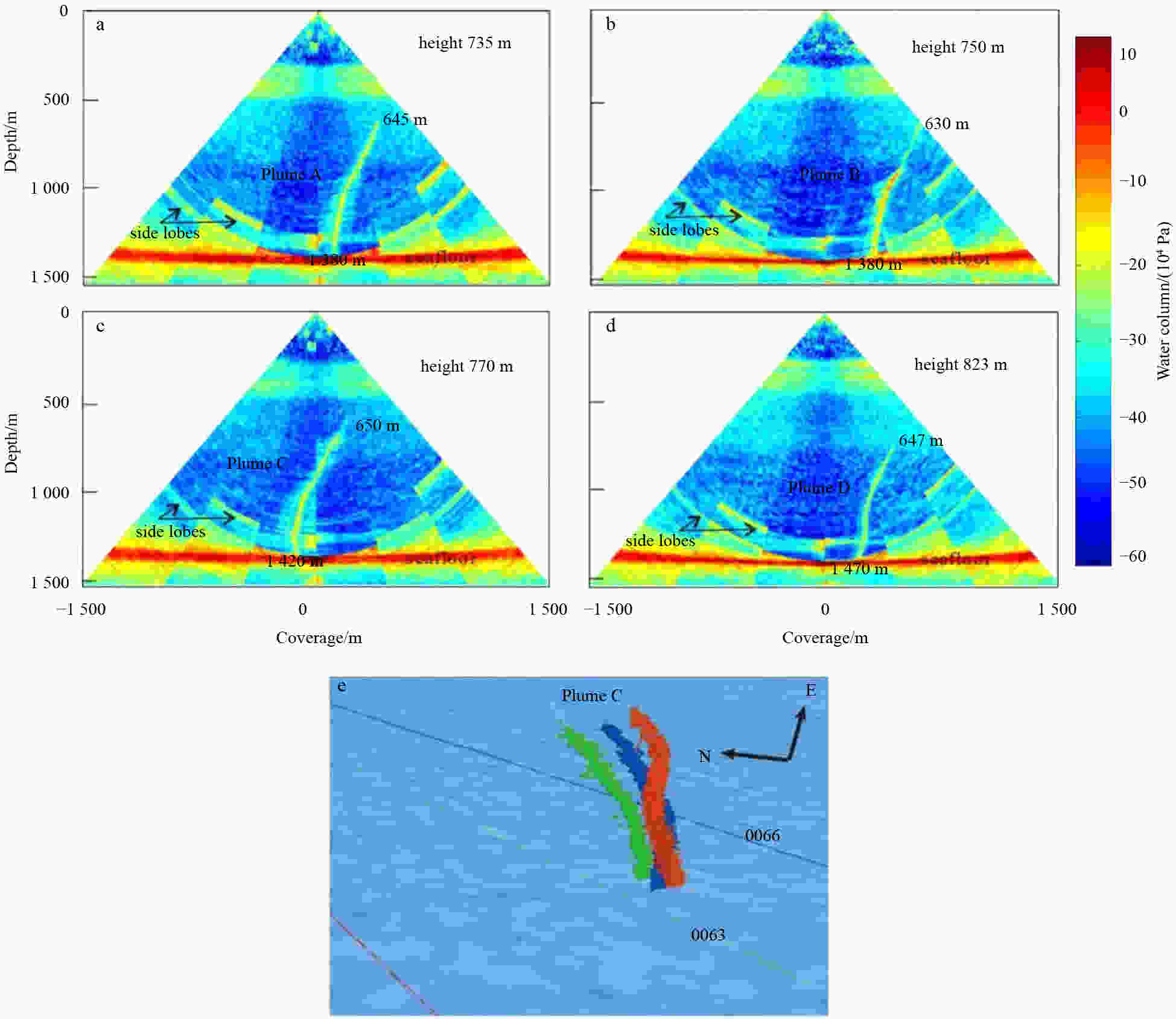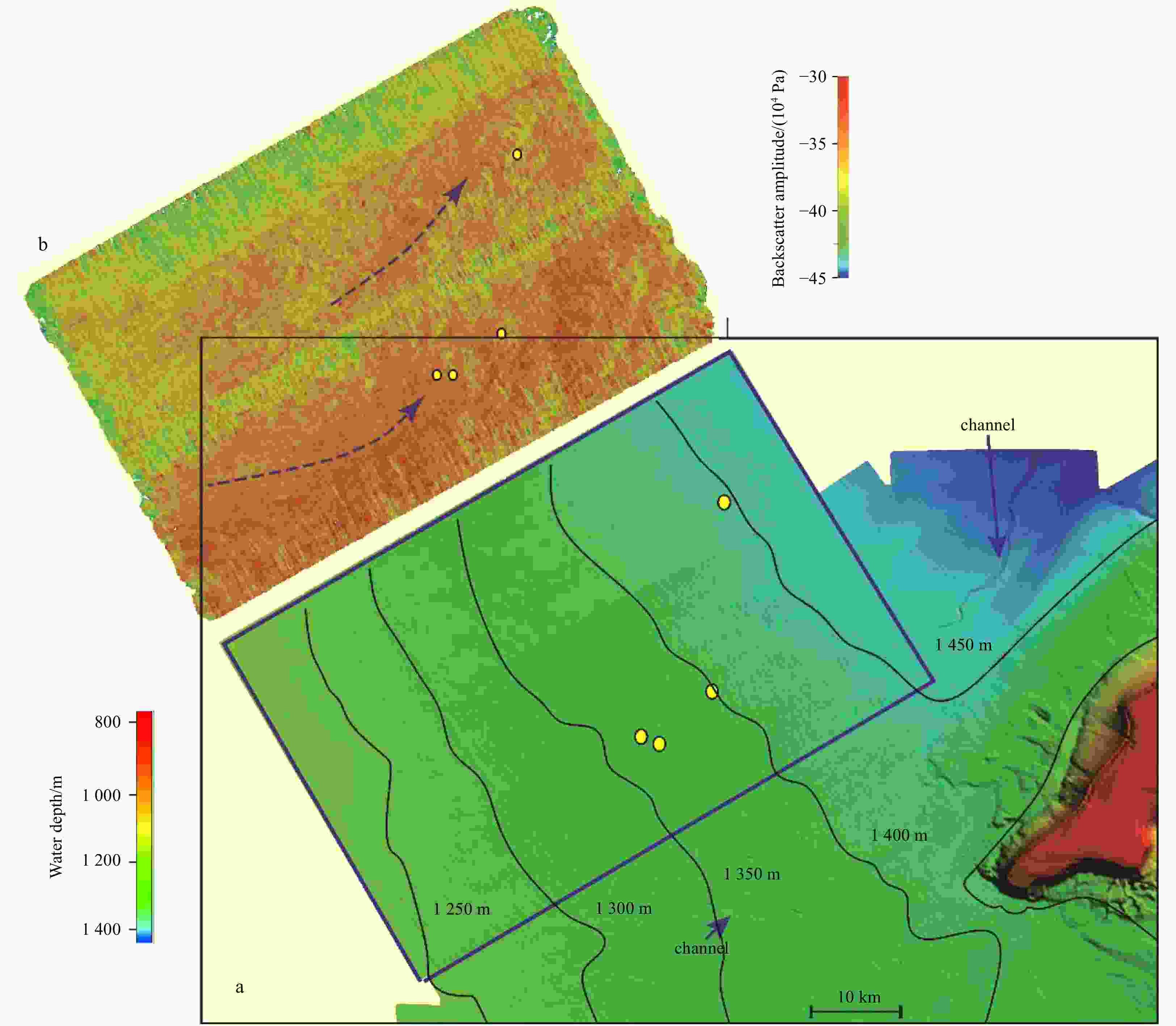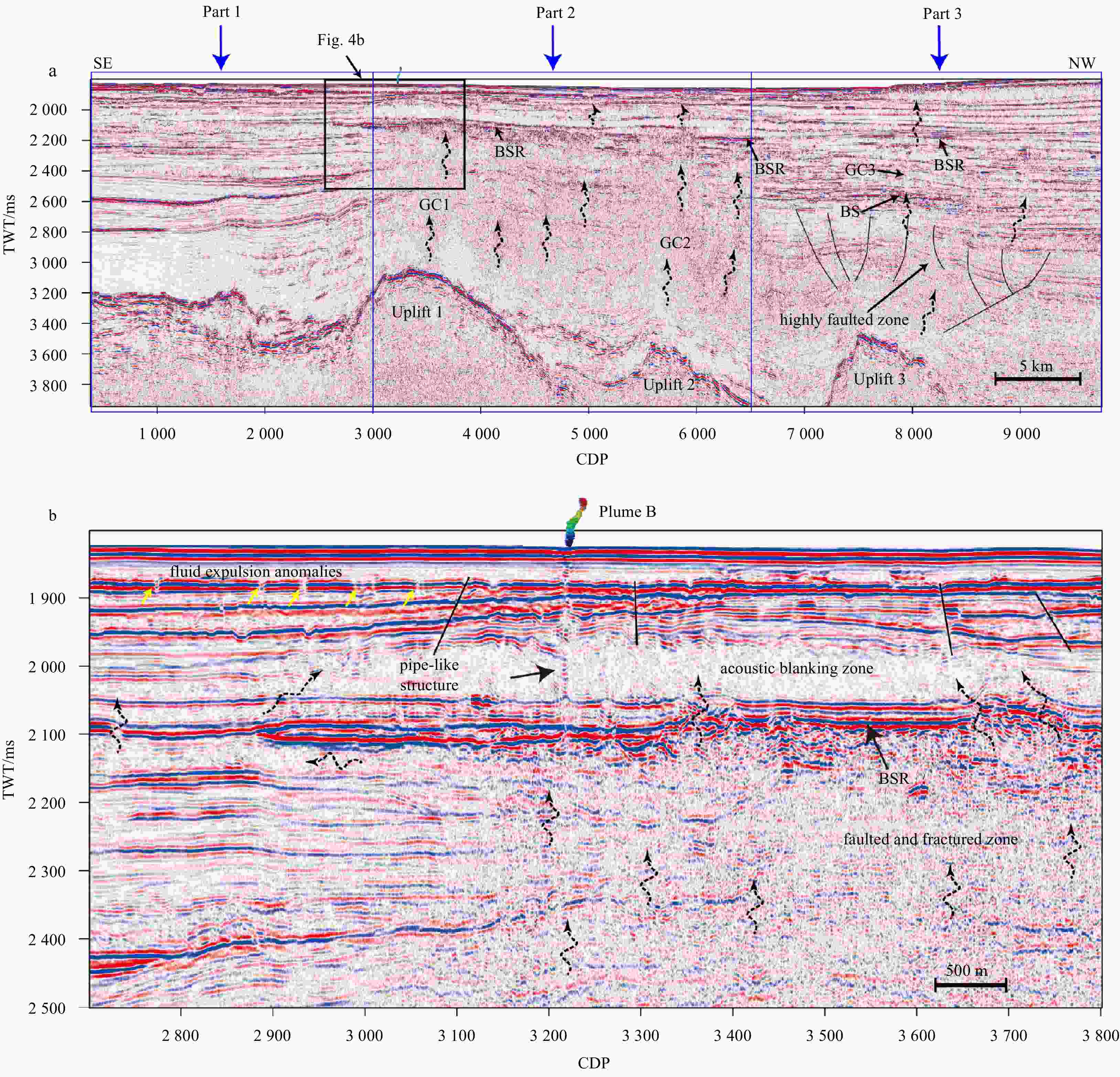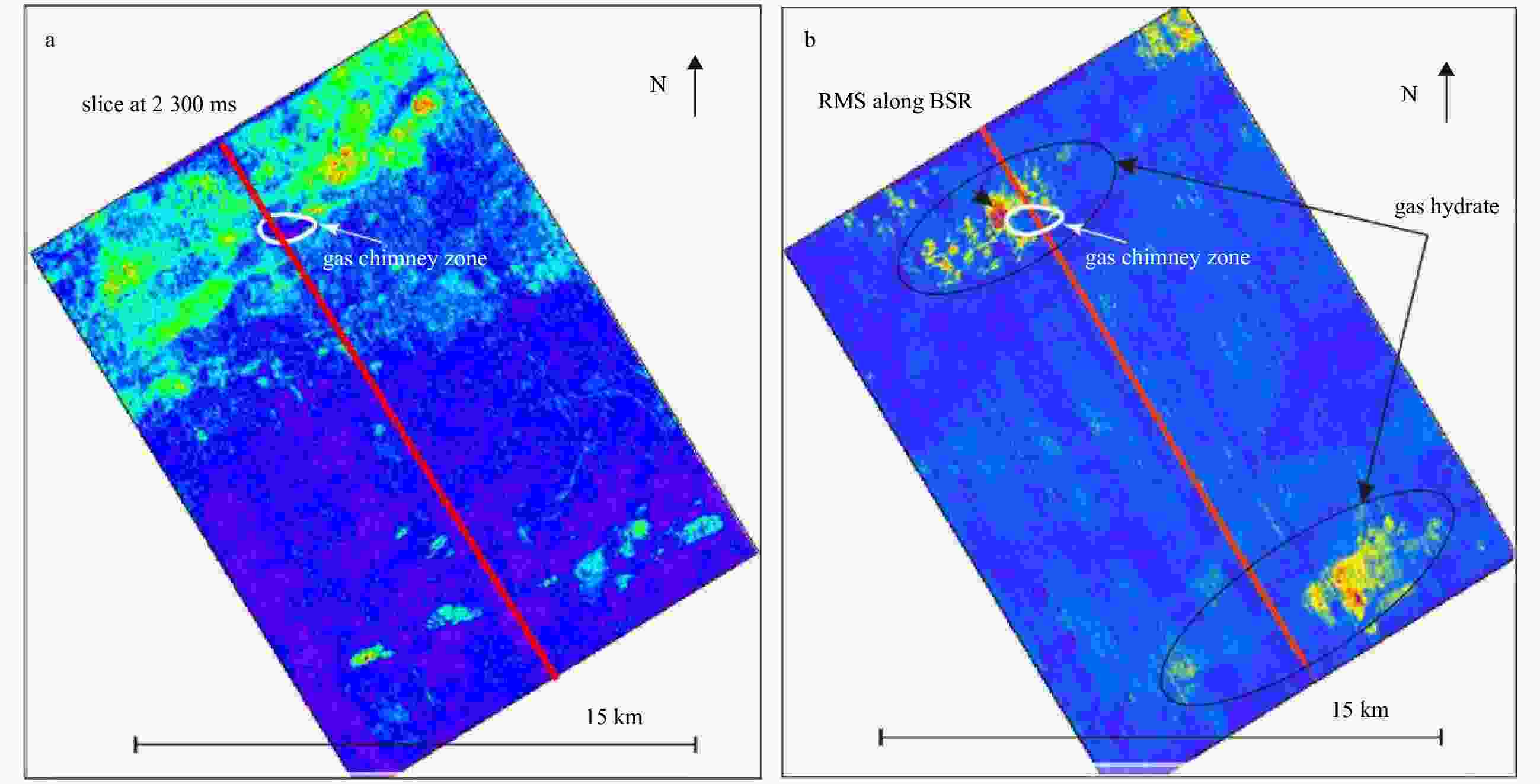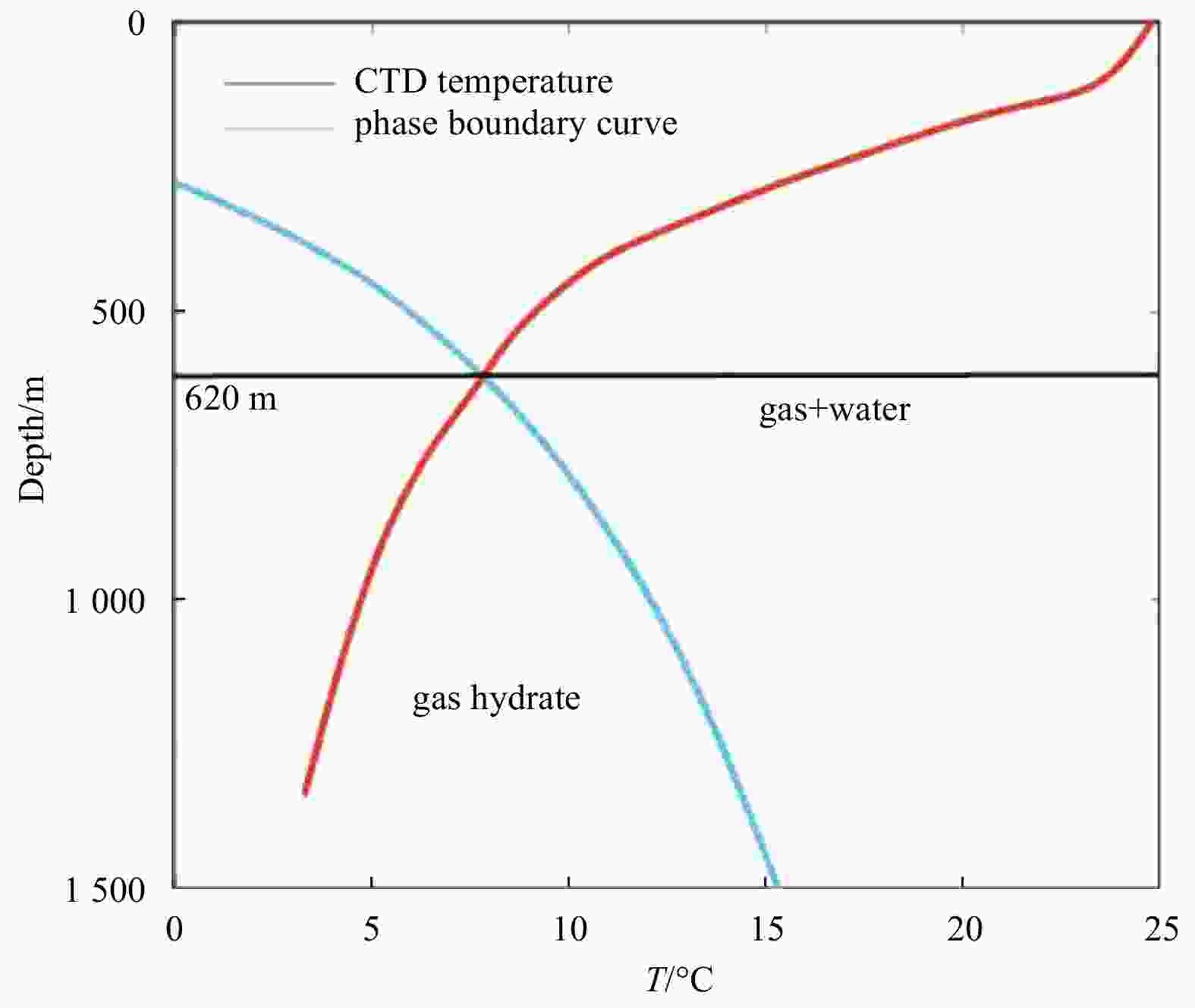Multi-beam and seismic investigations of the active Haima cold seeps, northwestern South China Sea
-
Abstract: To confirm the seabed fluid flow at the Haima cold seeps, an integrated study of multi-beam and seismic data reveals the morphology and fate of four bubble plumes and investigates the detailed subsurface structure of the active seepage area. The shapes of bubble plumes are not constant and influenced by the northeastward bottom currents, but the water depth where these bubble plumes disappear (630–650 m below the sea level) (mbsl) is very close to the upper limit of the gas hydrate stability zone in the water column (620 m below the sea level), as calculated from the CTD data within the study area, supporting the “hydrate skin” hypothesis. Gas chimneys directly below the bottom simulating reflectors, found at most sites, are speculated as essential pathways for both thermogenic gas and biogenic gas migrating from deep formations to the gas hydrate stability zone. The fracture network on the top of the basement uplift may be heavily gas-charged, which accounts for the chimney with several kilometers in diameter (beneath Plumes B and C). The much smaller gas chimney (beneath Plume D) may stem from gas saturated localized strong permeability zone. High-resolution seismic profiles reveal pipe-like structures, characterized by stacked localized amplitude anomalies, just beneath all the plumes, which act as the fluid conduits conveying gas from the gas hydrate-bearing sediments to the seafloor, feeding the gas plumes. The differences between these pipe-like structures indicate the dynamic process of gas seepage, which may be controlled by the build-up and dissipation of pore pressure. The 3D seismic data show high saturated gas hydrates with high RMS amplitude tend to cluster on the periphery of the gas chimney. Understanding the fluid migration and hydrate accumulation pattern of the Haima cold seeps can aid in the further exploration and study on the dynamic gas hydrate system in the South China Sea.
-
Key words:
- fluid escape /
- cold seep /
- natural gas hydrate /
- bubble plume /
- Qiongdongnan Basin /
- South China Sea
-
Figure 1. Location of the geological map on the northern slope of SCS (a); geological background of the Haima cold seeps, and the study area is surrounded by several sags (b); and four sites of gas bubble plumes (yellow circle), labeled as A, B, C, and D were observed in the multi-beam water-column data (c). The pink lines are 2D multichannel seismic lines that pass through the plumes. Note that Plumes B, C, and D are crossed by seismic lines Multi-Channel Seismic (MCS) 1236, MCS L440, MCS 1218, respectively. Near-seafloor gas hydrates were recovered at Sites ROV1 and ROV2 (red dots) at 3–8 m below the seafloor with a 9 m-long, 73 cm-wide, and 1 000 kg-weight gravity piston corer (PC). The black line through ROV1 and ROV2 is the seismic line shown in Wang et al. (2018b). ZRMB: Zhujiang River Mouth Basin, QDNB: Qiongdongnan Basin.
Figure 2. The water column images of gas bubble plumes (a, b, c and d), and the water column images of Plume C from different multi-beam lines (0060, 0063 and 0066) (e). In a, b, c and d, the water depths of the four plumes where they disappear are 645 m, 630 m, 650 m, and 647 m; the corresponding seafloor water depths are 1 380 m, 1 380 m, 1 420 m, and 1 470 m; thus the vertical lengths of the plumes, namely “height”, are 735 m, 750 m, 770 m, and 823 m, respectively. In e, the interval between successive lines is 3 h. Plume C is inclined to the northeast at all the three survey lines. The shape of Plume C seems to change over time, but its upper limit seems to be almost invariant (640 m ± 10 m).
Figure 4. Seismic expressions of the fluid process associated with Plume B. a. The 2D seismic line 1236 passing through Plume B, showing the uplifted basements and the overlying gas chimneys; and b. the detailed image of the zone denoted by the black box in Fig. 4a, which illustrates the faulted zone and the BSRs on the top of GC1. In a, the location of the seismic line is depicted in Fig. 1b, and the section is divided into three parts for further discussion. In b, an acoustic blanking zone is directly above the BSRs, through which a pipe-like structure rises to the seafloor and connects to Plume B. Wispy fluid expulsion anomalies, perhaps paleo-pockmarks, are indicated by yellow arrows. GC: gas chimney, BS: bright spot, BSR: bottom simulating reflector.
Figure 5. Seismic expressions of the fluid process associated with Plume C. a. Seismic section of MCS line L440 passing through Plume C, showing a basement uplift with a flat roof, topped by a large-scale gas chimney; and b. detailed image of the zone marked by the black box in Fig. 5a. In addition to Plume C, pockmarks (PM1 and PM2) are observed. The acoustic blanking zones and vertical amplitude anomalies are also shown between the seafloor and the BSRs. c. Zoomed figure showing PM1, PM2 and the corresponding underlying vertical anomalies; and d. zoomed figure showing the detailed structure beneath Plume C. GC: gas chimney, PM: pockmark, BSR: bottom simulating reflector, TWT: two-way traveltime.
Figure 6. Seismic expressions of the fluid process associated with Plume D. a. Seismic section of the MCS line 1218 passing through Plume D, showing a rough, fluctuant basement and a minor gas chimney; and b. detailed image of the zone marked by the black box in Fig. 6a. Enhanced reflection zones occur beneath the BSRs. Acoustic blanking zones emerge in the overlying strata. Atop of the gas chimney, a V-shaped anomaly exists, corresponding to the deflecting amplitude anomaly and Plume D. GC: gas chimney, BS: bright spot, BSR: bottom simulating reflector, TWT: two-way traveltime.
Figure 7. Seismic attributes associated with the cold seep. a. Time slice of the 3D seismic volume at 2 300 ms two-way traveltime; and b. RMS amplitude attribute derived from the 3D seismic volume. The red lines indicate the locations of part of the Line 1218 which passes through Plume D. The area where the gas chimney developed exhibits low-value features in both slices. In addition, several medium-high and high-value zones are observed in the north, northwest, and southeast of RMS amplitude attribute slice. BSR: bottom simulating reflector.
Table 1. Differences of the seismic expressions and plumes at the four seep sites
Site Seismic anomalies about fluid migration Conduit (pipe-like structure) Water depth of
termination of
plume/mbslDiameter of
the root of
plumes/mA / / 645 26 B gas chimney (>10 km wide), bright spot, paleo-pockmarks (?) strictly columnar, high amplitude 630 28 C gas chimney (>10 km wide), pockmarks diffuse, dimmed amplitude 650 50 D gas chimney (~1 km wide), enhanced reflections,
bright spot, dome-shaped anomalydeflecting, moderate amplitude 647 33 Note: “/” indicates that the corresponding feature is not found, and mbsl means m below the sea level. -
[1] Andresen K J. 2012. Fluid flow features in hydrocarbon plumbing systems: What do they tell us about the basin evolution?. Marine Geology, 332–334: 89–108. doi: 10.1016/j.margeo.2012.07.006 [2] Archer D. 2007. Methane hydrate stability and anthropogenic climate change. Biogeosciences, 4(4): 521–544. doi: 10.5194/bg-4-521-2007 [3] Bai Yang, Song Haibin, Guan Yongxian, et al. 2014. Structural characteristics and genesis of pockmarks in the northwest of the South China Sea derived from reflective seismic and multibeam data. Chinese Journal of Geophysics (in Chinese), 57(7): 2208–2222 [4] Bangs N L B, Hornbach M J, Berndt C. 2011. The mechanics of intermittent methane venting at South Hydrate Ridge inferred from 4D seismic surveying. Earth and Planetary Science Letters, 310(1–2): 105–112. doi: 10.1016/j.jpgl.2011.06.022 [5] Barnard A, Sager W W, Snow J E, et al. 2015. Subsea gas emissions from the Barbados accretionary complex. Marine and Petroleum Geology, 64: 31–42. doi: 10.1016/j.marpetgeo.2015.02.008 [6] Brothers D S, Ruppel C, Kluesner J W, et al. 2014. Seabed fluid expulsion along the upper slope and outer shelf of the U.S. Atlantic continental margin. Geophysical Research Letters, 41(1): 96–101. doi: 10.1002/2013GL058048 [7] Brothers L L, Van Dover C L, German C R, et al. 2013. Evidence for extensive methane venting on the southeastern U.S. Atlantic margin. Geology, 41(7): 807–810. doi: 10.1130/G34217.1 [8] Bünz S, Mienert J, Berndt C. 2003. Geological controls on the Storegga gas-hydrate system of the Mid-Norwegian Continental Margin. Earth and Planetary Science Letters, 209(3–4): 291–307. doi: 10.1016/S0012-821X(03)00097-9 [9] Cartwright J, Huuse M, Aplin A. 2007. Seal bypass systems. AAPG Bulletin, 91(8): 1141–1166. doi: 10.1306/04090705181 [10] Chen Jiangxin, Guan Yongxian, Song Haibin, et al. 2015a. Distribution characteristics and geological implications of pockmarks and mud volcanoes in the northern and western continental margins of the South China Sea. Chinese Journal of Geophysics (in Chinese), 58(3): 919–938 [11] Chen S C, Hsu S, Wang Y, et al. 2014. Distribution and characters of the mud diapirs and mud volcanoes off southwest Taiwan. Journal of Asian Earth Sciences, 92: 201–214. doi: 10.1016/j.jseaes.2013.10.009 [12] Chen Duofu, Huang Yongyang, Yuan Xunlai, et al. 2005. Seep carbonates and preserved methane oxidizing archaea and sulfate reducing bacteria fossils suggest recent gas venting on the seafloor in the Northeastern South China Sea. Marine and Petroleum Geology, 22(5): 613–621. doi: 10.1016/j.marpetgeo.2005.05.002 [13] Chen Jiangxin, Song Haibin, Guan Yongxian, et al. 2015b. Morphologies, classification and genesis of pockmarks, mud volcanoes and associated fluid escape features in the northern Zhongjiannan Basin, South China Sea. Deep Sea Research Part II: Topical Studies in Oceanography, 122: 106–117. doi: 10.1016/j.dsr2.2015.11.007 [14] Chen Jiangxin, Song Haibin, Guan Yongxian, et al. 2018. Geological and oceanographic controls on seabed fluid escape structures in the northern Zhongjiannan Basin, South China Sea. Journal of Asian Earth Sciences, 168: 38–47. doi: 10.1016/j.jseaes.2018.04.027 [15] Chun J H, Ryu B J, Son B K, et al. 2011. Sediment mounds and other sedimentary features related to hydrate occurrences in a columnar seismic blanking zone of the Ulleung Basin, East Sea, Korea. Marine and Petroleum Geology, 28(10): 1787–1800. doi: 10.1016/j.marpetgeo.2011.06.006 [16] Crutchley G J, Klaeschen D, Planert L, et al. 2014. The impact of fluid advection on gas hydrate stability: investigations at sites of methane seepage offshore Costa Rica. Earth and Planetary Science Letters, 401: 95–109. doi: 10.1016/j.jpgl.2014.05.045 [17] Diaconescu C C, Kieckhefer R M, Knapp J H. 2001. Geophysical evidence for gas hydrates in the deep water of the South Caspian Basin, Azerbaijan. Marine and Petroleum Geology, 18(2): 209–221. doi: 10.1016/S0264-8172(00)00061-1 [18] Etiope G. 2012. Methane uncovered. Nature Geoscience, 5(6): 373–374. doi: 10.1038/ngeo1483 [19] Fang Yunxin, Wei Jiangong, Lu Hailong, et al. 2019. Chemical and structural characteristics of gas hydrates from the Haima cold seeps in the Qiongdongnan Basin of the South China Sea. Journal of Asian Earth Sciences, 182: 103924. doi: 10.1016/j.jseaes.2019.103924 [20] Feng Dong, Qiu Jianwen, Hu Yu, et al. 2018. Cold seep systems in the South China Sea: An overview. Journal of Asian Earth Sciences, 168: 3–16. doi: 10.1016/j.jseaes.2018.09.021 [21] Feng Junxi, Yang Shengxiong, Wang Hongbin, et al. 2019. Methane source and turnover in the shallow sediments to the west of Haima cold seeps on the northwestern slope of the south China Sea. Geofluids, 2019: 1010824 [22] Foucher J P, Westbrook G K, Boetius A, et al. 2009. Structure and drivers of cold seep ecosystems. Oceanography, 22(1): 92–109. doi: 10.5670/oceanog.2009.11 [23] Gay A, Mourgues R, Berndt C, et al. 2012. Anatomy of a fluid pipe in the Norway Basin: Initiation, propagation and 3D shape. Marine Geology, 332-334: 75–88. doi: 10.1016/j.margeo.2012.08.010 [24] Greinert J, Artemov Y, Egorov V, et al. 2006. 1300-m-high rising bubbles from mud volcanoes at 2080 m in the Black Sea: Hydroacoustic characteristics and temporal variability. Earth and Planetary Science Letters, 244(1–2): 1–15. doi: 10.1016/j.jpgl.2006.02.011 [25] Guan Hongxiang, Birgel D, Peckmann J, et al. 2018. Lipid biomarker patterns of authigenic carbonates reveal fluid composition and seepage intensity at Haima cold seeps, South China Sea. Journal of Asian Earth Sciences, 168: 163–172. doi: 10.1016/j.jseaes.2018.04.035 [26] Haacke R R, Hyndman R D, Park K P, et al. 2009. Migration and venting of deep gases into the ocean through hydrate-choked chimneys offshore Korea. Geology, 37(6): 531–534. doi: 10.1130/G25681A.1 [27] Han Xiqiu, Suess E, Huang Yongyang, et al. 2008. Jiulong methane reef: Microbial mediation of seep carbonates in the South China Sea. Marine Geology, 249(3–4): 243–256. doi: 10.1016/j.margeo.2007.11.012 [28] Han Xiqiu, Suess E, Liebetrau V, et al. 2014. Past methane release events and environmental conditions at the upper continental slope of the South China Sea: constraints by seep carbonates. International Journal of Earth Sciences, 103(7): 1873–1887. doi: 10.1007/s00531-014-1018-5 [29] He Jiaxiong, Su Pibo, Lu Zhenquan, et al. 2015. Prediction of gas sources of natural gas hydrate in the Qiongdongnan Basin, northern South China Sea, and its migration, accumulation and reservoir formation pattern. Natural Gas Industry (in Chinese), 35(8): 19–29 [30] He Jiaxiong, Yan Wen, Zhu Youhai, et al. 2013. Bio-genetic and sub-biogenetic gas resource potential and genetic types of natural gas hydrates in the northern marginal basins of South China Sea. Natural Gas Industry (in Chinese), 33(6): 121–134 [31] Heeschen K U, Tréhu A M, Collier R W, et al. 2003. Distribution and height of methane bubble plumes on the Cascadia Margin characterized by acoustic imaging. Geophysical Research Letters, 30(12): 1643 [32] Holbrook W S, Hoskins H, Wood W T, et al. 1996. Methane hydrate and free gas on the Blake ridge from vertical seismic profiling. Science, 273(5283): 1840–1843. doi: 10.1126/science.273.5283.1840 [33] Hovland M, Svensen H. 2006. Submarine pingoes: Indicators of shallow gas hydrates in a pockmark at Nyegga, Norwegian Sea. Marine Geology, 228(1–4): 15–23. doi: 10.1016/j.margeo.2005.12.005 [34] Hu Yu, Luo Min, Liang Qianyong, et al. 2019. Pore fluid compositions and inferred fluid flow patterns at the Haima cold seeps of the South China Sea. Marine and Petroleum Geology, 103: 29–40. doi: 10.1016/j.marpetgeo.2019.01.007 [35] Hu Bo, Wang Liangshu, Yan Wenbo, et al. 2013. The tectonic evolution of the Qiongdongnan Basin in the northern margin of the South China Sea. Journal of Asian Earth Sciences, 77: 163–182. doi: 10.1016/j.jseaes.2013.08.022 [36] Huang Baojia, Tian Hui, Li Xushen, et al. 2016. Geochemistry, origin and accumulation of natural gases in the deepwater area of the Qiongdongnan Basin, South China Sea. Marine and Petroleum Geology, 72: 254–267. doi: 10.1016/j.marpetgeo.2016.02.007 [37] Huang Baojia, Wang Zhenfeng, Liang Gang. 2014. Natural gas source and migration-accumulation pattern in the central canyon, the deep water area, Qiongdongnan Basin. China Offshore Oil and Gas (in Chinese), 26(5): 8–14 [38] Huang Baojia, Xiao Xianming, Li Xushen, et al. 2009. Spatial distribution and geochemistry of the nearshore gas seepages and their implications to natural gas migration in the Yinggehai Basin, offshore South China Sea. Marine and Petroleum Geology, 26(6): 928–935. doi: 10.1016/j.marpetgeo.2008.04.009 [39] Hustoft S, Mienert J, Bünz S, et al. 2007. High-resolution 3D-seismic data indicate focussed fluid migration pathways above polygonal fault systems of the Mid-Norwegian Margin. Marine Geology, 245(1–4): 89–106. doi: 10.1016/j.margeo.2007.07.004 [40] Hyndman R D, Spence G D. 1992. A seismic study of methane hydrate marine bottom simulating reflectors. Journal of Geophysical Research: Solid Earth, 97(B5): 6683–6698. doi: 10.1029/92JB00234 [41] Isaksen I S A, Gauss M, Myhre G, et al. 2011. Strong atmospheric chemistry feedback to climate warming from Arctic methane emissions. Global Biogeochemical Cycles, 25(2): GB2002 [42] Jin Jiapeng, Wang Xiujuan, Guo Yiquan, et al. 2020. Geological controls on the occurrence of recently formed highly concentrated gas hydrate accumulations in the Shenhu area, South China Sea. Marine and Petroleum Geology, 116: 104294. doi: 10.1016/j.marpetgeo.2020.104294 [43] Judd A G. 2003. The global importance and context of methane escape from the seabed. Geo-Marine Letters, 23(3–4): 147–154. doi: 10.1007/s00367-003-0136-z [44] Judd A, Hovland M. 2007. Seabed Fluid Flow: the Impact on Geology, Biology and the Marine Environment. Cambridge: Cambridge University Press [45] Karstens J, Berndt C. 2015. Seismic chimneys in the Southern Viking Graben-Implications for palaeo fluid migration and overpressure evolution. Earth and Planetary Science Letters, 412: 88–100. doi: 10.1016/j.jpgl.2014.12.017 [46] Klaucke I, Weinrebe W, Petersen C J, et al. 2010. Temporal variability of gas seeps offshore New Zealand: multi-frequency geoacoustic imaging of the Wairarapa area, Hikurangi margin. Marine Geology, 272(1-4): 49–58. doi: 10.1016/j.margeo.2009.02.009 [47] Li Changjun, Huang Ting. 2016. Simulation of gas bubbles with gas hydrates rising in deep water. Ocean Engineering, 112: 16–24. doi: 10.1016/j.oceaneng.2015.12.002 [48] Li Wenhao, Zhang Zhihuang, Li Youchuan, et al. 2012. New perspective of Miocene marine hydrocarbon source rocks in deep-water area in Qiongdongnan Basin of northern South China Sea. Acta Oceanologica Sinica, 31(5): 107–114. doi: 10.1007/s13131-012-0241-9 [49] Liang Qianyong, Hu Y, Feng Dong, et al. 2017. Authigenic carbonates from newly discovered active cold seeps on the northwestern slope of the South China Sea: Constraints on fluid sources, formation environments, and seepage dynamics. Deep Sea Research Part I: Oceanographic Research Papers, 124: 31–41. doi: 10.1016/j.dsr.2017.04.015 [50] Liang Jinqiang, Zhang Wei, Lu Jing’an, et al. 2019. Geological occurrence and accumulation mechanism of natural gas hydrates in the eastern Qiongdongnan Basin of the South China Sea: Insights from site GMGS5-W9-2018. Marine Geology, 418: 106042. doi: 10.1016/j.margeo.2019.106042 [51] Liu Bin, Liu Shengxuan. 2017. Gas bubble plumes observed at north slope of South China Sea from multi-beam water column data. Haiyang Xuebao (in Chinese), 39(9): 83–89 [52] Loher M, Marcon Y, Pape T, et al. 2018. Seafloor sealing, doming, and collapse associated with gas seeps and authigenic carbonate structures at Venere mud volcano, Central Mediterranean. Deep Sea Research Part I: Oceanographic Research Papers, 137: 76–96. doi: 10.1016/j.dsr.2018.04.006 [53] Løseth H, Gading M, Wensaas L. 2009. Hydrocarbon leakage interpreted on seismic data. Marine and Petroleum Geology, 26(7): 1304–1319. doi: 10.1016/j.marpetgeo.2008.09.008 [54] Løseth H, Wensaas L, Arntsen B, et al. 2011. 1000 m long gas blow-out pipes. Marine and Petroleum Geology, 28(5): 1047–1060. doi: 10.1016/j.marpetgeo.2010.10.001 [55] Lüdmann T, Wong H K. 1999. Neotectonic regime on the passive continental margin of the northern south China Sea. Tectonophysics, 311(1–4): 113–138. doi: 10.1016/S0040-1951(99)00155-9 [56] Ma Wenhong, He Jiaxiong, Yao Yongjian, et al. 2008. Characteristics of tertiary sediments and main Source Rocks, Northern South China Sea. Natural Gas Geoscience (in Chinese), 19(1): 41–48 [57] Maestrelli D, Iacopini D, Jihad A A, et al. 2017. Seismic and structural characterization of fluid escape pipes using 3D and partial stack seismic from the Loyal Field (Scotland, UK): a multiphase and repeated intrusive mechanism. Marine and Petroleum Geology, 88: 489–510. doi: 10.1016/j.marpetgeo.2017.08.016 [58] Myhre C L, Ferré B, Platt S M, et al. 2016. Extensive release of methane from Arctic seabed west of Svalbard during summer 2014 does not influence the atmosphere. Geophysical Research Letters, 43(9): 4624–4631. doi: 10.1002/2016GL068999 [59] Paganoni M, Cartwright J A, Foschi M, et al. 2016. Structure II gas hydrates found below the bottom-simulating reflector. Geophysical Research Letters, 43(11): 5696–5706. doi: 10.1002/2016GL069452 [60] Paull C K, Normark W R, Ussler III B, et al. 2008. Association among active seafloor deformation, mound formation, and gas hydrate growth and accumulation within the seafloor of the Santa Monica Basin, offshore California. Marine Geology, 250(3–4): 258–275. doi: 10.1016/j.margeo.2008.01.011 [61] Petersen C J, Bünz S, Hustoft S, et al. 2010. High-resolution P-Cable 3D seismic imaging of gas chimney structures in gas hydrated sediments of an Arctic sediment drift. Marine and Petroleum Geology, 27(9): 1981–1994. doi: 10.1016/j.marpetgeo.2010.06.006 [62] Plaza-Faverola A, Bünz S, Mienert J. 2010. Fluid distributions inferred from P-wave velocity and reflection seismic amplitude anomalies beneath the Nyegga pockmark field of the mid-Norwegian margin. Marine and Petroleum Geology, 27(1): 46–60. doi: 10.1016/j.marpetgeo.2009.07.007 [63] Prinzhofer A, Deville E. 2013. Origins of hydrocarbon gas seeping out from offshore mud volcanoes in the Nile delta. Tectonophysics, 591: 52–61. doi: 10.1016/j.tecto.2011.06.028 [64] Qian Jin, Wang Xiujuan, Collett T S, et al. 2018. Downhole log evidence for the coexistence of structure II gas hydrate and free gas below the bottom simulating reflector in the South China Sea. Marine and Petroleum Geology, 98: 662–674. doi: 10.1016/j.marpetgeo.2018.09.024 [65] Qin Xuwen, Lu Jingan, Lu Hailong, et al. 2020. Coexistence of natural gas hydrate, free gas and water in the gas hydrate system in the Shenhu Area, South China Sea. China Geology, 3(2): 210–220 [66] Rehder G, Brewer P W, Peltzer E T, et al. 2002. Enhanced lifetime of methane bubble streams within the deep ocean. Geophysical Research Letters, 29(15): 1731 [67] Riedel M, Novosel I, Spence G D, et al. 2006. Geophysical and geochemical signatures associated with gas hydrate-related venting in the northern Cascadia margin. GSA Bulletin, 118(1–2): 23–38. doi: 10.1130/B25720.1 [68] Römer M, Torres M, Kasten S, et al. 2014. First evidence of widespread active methane seepage in the Southern Ocean, off the sub-Antarctic island of South Georgia. Earth and Planetary Science Letters, 403: 166–177. doi: 10.1016/j.jpgl.2014.06.036 [69] Ru Ke, Pigott J D. 1986. Episodic rifting and subsidence in the South China Sea. AAPG Bulletin, 70(9): 1136–1155 [70] Ruppel C D, Kessler J D. 2017. The interaction of climate change and methane hydrates. Reviews of Geophysics, 55(1): 126–168. doi: 10.1002/2016RG000534 [71] Sauter E J, Muyakshin S I, Charlou J L, et al. 2006. Methane discharge from a deep-sea submarine mud volcano into the upper water column by gas hydrate-coated methane bubbles. Earth and Planetary Science Letters, 243(3–4): 354–365. doi: 10.1016/j.jpgl.2006.01.041 [72] Schwalenberg K, Wood W, Pecher I, et al. 2010. Preliminary interpretation of electromagnetic, heat flow, seismic, and geochemical data for gas hydrate distribution across the Porangahau Ridge, New Zealand. Marine Geology, 272(1–4): 89–98. doi: 10.1016/j.margeo.2009.10.024 [73] Shi Xiaobin, Jiang Haiyan, Yang Jun, et al. 2017. Models of the rapid post-rift Subsidence in the eastern Qiongdongnan Basin, South China Sea: implications for the development of the deep thermal anomaly. Basin Research, 29(3): 340–362. doi: 10.1111/bre.12179 [74] Shi Wanzhong, Xie Yuhong, Wang Zhenfeng, et al. 2013. Characteristics of overpressure distribution and its implication for hydrocarbon exploration in the Qiongdongnan Basin. Journal of Asian Earth Sciences, 66: 150–165. doi: 10.1016/j.jseaes.2012.12.037 [75] Skarke A, Ruppel C, Kodis M, et al. 2014. Widespread methane leakage from the sea floor on the northern US Atlantic Margin. Nature Geoscience, 7(9): 657–661. doi: 10.1038/ngeo2232 [76] Sloan Jr E D. 1998. Clathrate Hydrates of Natural Gases. 2nd ed. New York: Marcel Dekker [77] Solomon E A, Kastner M, MacDonald I R, et al. 2009. Considerable methane fluxes to the atmosphere from hydrocarbon seeps in the Gulf of Mexico. Nature Geoscience, 2(8): 561–565. doi: 10.1038/ngeo574 [78] Suess E. 2014. Marine cold seeps and their manifestations: geological control, biogeochemical criteria and environmental conditions. International Journal of Earth Sciences, 103(7): 1889–1916. doi: 10.1007/s00531-014-1010-0 [79] Sun Yunbao, Wu Shiguo, Dong Dongdond, et al. 2012. Gas hydrates associated with gas chimneys in fine-grained sediments of the northern South China Sea. Marine Geology, 311–314(1): 32–40. doi: 10.1016/j.margeo.2012.04.003 [80] Tong Hongpeng, Feng Dong, Cheng Hai, et al. 2013. Authigenic carbonates from seeps on the northern continental slope of the South China Sea: New insights into fluid sources and geochronology. Marine and Petroleum Geology, 43: 260–271. doi: 10.1016/j.marpetgeo.2013.01.011 [81] Wang Xudong, Li Niu, Feng Dong, et al. 2018a. Using chemical compositions of sediments to constrain methane seepage dynamics: a case study from Haima cold seeps of the South China Sea. Journal of Asian Earth Sciences, 168: 137–144. doi: 10.1016/j.jseaes.2018.11.011 [82] Wang Lijie, Sun Zhen, Yang Jinhai, et al. 2019. Seismic characteristics and evolution of post-rift igneous complexes and hydrothermal vents in the Lingshui sag (Qiongdongnan Basin), northwestern South China Sea. Marine Geology, 418: 106043. doi: 10.1016/j.margeo.2019.106043 [83] Wang Jiliang, Wu Shiguo, Kong Xiu, et al. 2018b. Subsurface fluid flow at an active cold seep area in the Qiongdongnan Basin, northern South China Sea. Journal of Asian Earth Sciences, 168: 17–26. doi: 10.1016/j.jseaes.2018.06.001 [84] Warzinski R P, Lynn R, Haljasmaa I, et al. 2014. Dynamic morphology of gas hydrate on a methane bubble in water: observations and new insights for hydrate film models. Geophysical Research Letters, 41(19): 6841–6847. doi: 10.1002/2014GL061665 [85] Wei Jiangong, Li Jiwei, Wu Tingting, et al. 2020. Geologically controlled intermittent gas eruption and its impact on bottom water temperature and chemosynthetic communities—A case study in the “HaiMa” cold seeps, South China Sea. Geological Journal, 55(9): 6066–6078. doi: 10.1002/gj.3780 [86] Wei Jiangong, Liang Jinqiang, Lu Jingan, et al. 2019. Characteristics and dynamics of gas hydrate systems in the northwestern South China Sea—Results of the fifth gas hydrate drilling expedition. Marine and Petroleum Geology, 110: 287–298. doi: 10.1016/j.marpetgeo.2019.07.028 [87] Westbrook G K, Thatcher K E, Rohling E J, et al. 2009. Escape of methane gas from the seabed along the West Spitsbergen continental margin. Geophysical Research Letters, 36(15): L15608 [88] Yang Li, Liu Bin, Xu Mengjie, et al. 2018. Characteristics of active cold seepages in Qiongdongnan Sea area of the northern South China Sea. Chinese Journal of Geophysics (in Chinese), 61(7): 2905–2914 [89] Ye Jianliang, Wei Jiangong, Liang Jinqiang, et al. 2019. Complex gas hydrate system in a gas chimney, South China Sea. Marine and Petroleum Geology, 104: 29–39. doi: 10.1016/j.marpetgeo.2019.03.023 [90] Yoo D G, Kang N K, Yi B Y, et al. 2013. Occurrence and seismic characteristics of gas hydrate in the Ulleung Basin, East Sea. Marine and Petroleum Geology, 47: 236–247. doi: 10.1016/j.marpetgeo.2013.07.001 [91] Yuan Yusong, Zhu Weilin, Mi Lijun, et al. 2009. “Uniform geothermal gradient” and heat flow in the Qiongdongnan and Pearl River Mouth Basins of the South China Sea. Marine and Petroleum Geology, 26(7): 1152–1162. doi: 10.1016/j.marpetgeo.2008.08.008 [92] Zhang Wei, Liang Jinqiang, Lu Jing’an, et al. 2017. Accumulation features and mechanisms of high saturation natural gas hydrate in Shenhu Area, northern South China Sea. Petroleum Exploration and Development, 44(5): 708–719. doi: 10.1016/S1876-3804(17)30082-4 [93] Zhang Wei, Liang Jinqiang, Su Pibo, et al. 2019. Distribution and characteristics of mud diapirs, gas chimneys, and bottom simulating reflectors associated with hydrocarbon migration and gas hydrate accumulation in the Qiongdongnan Basin, northern slope of the South China Sea. Geological Journal, 54(6): 3556–3573. doi: 10.1002/gj.3351 [94] Zhang Gongcheng, Zeng Qingbo, Su Long, et al. 2016. Accumulation mechanism of LS 17-2 deep water giant gas field in Qiongdongnan Basin. Acta Petrolei Sinica (in Chinese), 37(S1): 34–46 [95] Zhao Zhongxian, Sun Zhen, Wang Zhenfeng, et al. 2015. The high resolution sedimentary filling in Qiongdongnan Basin, Northern South China Sea. Marine Geology, 361: 11–24. doi: 10.1016/j.margeo.2015.01.002 [96] Zhao Yanghui, Tong Dianjun, Song Ying, et al. 2016. Seismic reflection characteristics and evolution of intrusions in the Qiongdongnan Basin: Implications for the rifting of the South China Sea. Journal of Earth Science, 27(4): 642–653. doi: 10.1007/s12583-016-0708-2 [97] Zhu Weilin, Huang Baojia, Mi Lijun, et al. 2009. Geochemistry, origin, and deep-water exploration potential of natural gases in the Pearl River Mouth and Qiongdongnan Basins, South China Sea. AAPG Bulletin, 93(6): 741–761. doi: 10.1306/02170908099 -




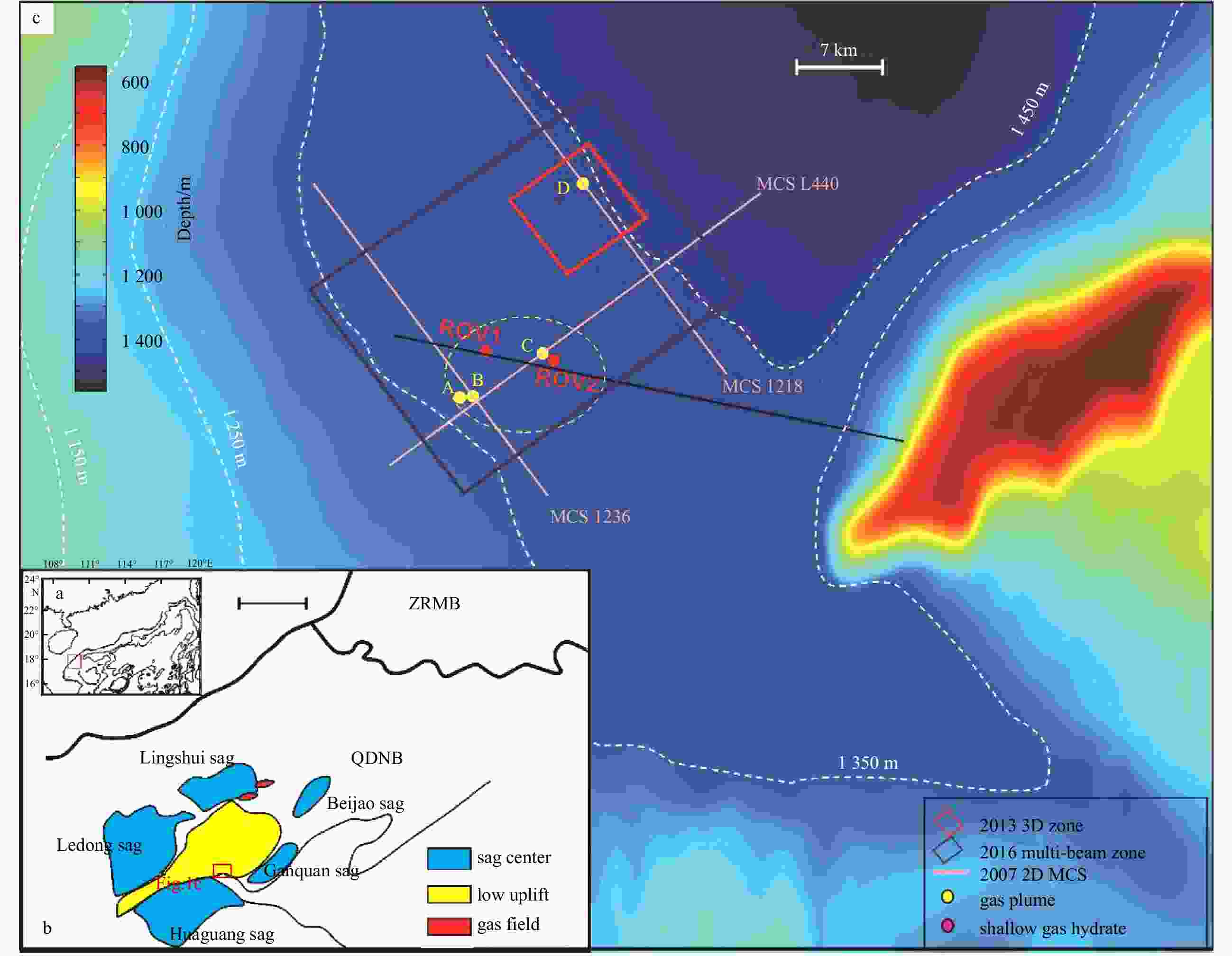
 下载:
下载:
